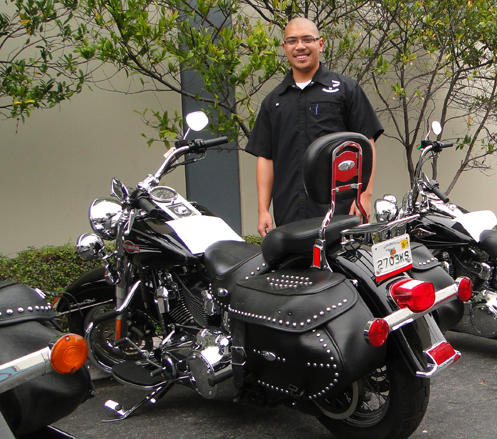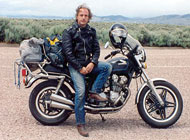Examiner Resurrection: Decoding the Harley mystique
Monday, December 31st, 2018OK, I admit, I’m just like you, I’m really busy this holiday season and I’m not averse to taking the easy way out: I’m putting up some Examiner Resurrection pieces. We’re going back here to 2010, but this is still relevant.
I spent four days on a Harley-Davidson Heritage Softail recently, hoping to understand at last the reasons why so many people are so fanatically devoted to the brand. I recapped my thoughts the first couple days out but now I’m ready to speak about my total experience and the conclusions I’ve reached.
Hint: I’m not converted, but I think I understand more now.
Ease of riding
The No. 1 understanding I came to on the Harley is that this bike is just incredibly easy to ride. Let’s compare it to my primary bike, my 1999 Kawasaki Concours.
The Concours is a tall bike to begin with, and with my 30-inch inseam it took some getting used to. The Softail has a much lower seat height, making it very easy for me to plant my feet widely and firmly on the ground at a stop. The Connie also has a 7.5-gallon gas tank that sits way up high, making for a very high center of gravity. Center of gravity on the Softail is very low, which makes the handling much more stable at low speeds. I never once came anywhere close to dropping it, whereas I have dropped the Kawi a couple times.
The power delivery on the Softail is very different from what I’m accustomed to so that took some getting used to. My Kawi has a high-revving engine and it has a ton of power. It’s very fast and the gearing is such that you don’t have to shift constantly in situations where you’re frequently speeding up and slowing down. My first impression of the Softail was that I all too frequently needed to downshift from the upper gears. To a certain extent I think that is true, but what I found with experience is that mostly that’s just the low-rev, loping v-twin and it would go along fine at the slower speed but then pick right back up with the twist of the throttle.
The bottom line here is that, while it probably took me two years to become totally comfortable on my Concours, I was right at home on the Softail within an hour or two. Now, having gotten comfortable on the Connie, I’m extremely comfortable on it and like it very much. And with longer legs it wouldn’t have taken that long. But I don’t think most people are willing to be that patient, so I can see the attraction of the Harley.
Riding comfort
Having a broad, well-padded seat was a real joy for me on that Softail. My other bike, my 1980 Honda CB750 Custom, has a reasonably comfortable seat but after doing a ride to California and back on a trip that included numerous long-mileage days, I swore never to do that again. I went out and bought my Concours. The Connie is a much better touring bike but even its seat gets hard after awhile. The seat on the Softail was a huge improvement.
Another thing I liked was the floorboards. With the floorboards I could shift my foot position a little or a lot, and even stretch my legs out completely straight. The key here is the knees. None of my buddies likes trading bikes with me and I think that has a lot to do with their aging knees. I suspect that sitting with your knees always bent as you must when your pegs are below you is just not something that works for them any more.
I, on the other hand, prefer to have my pegs beneath me because I want to stand up when I go over a bump and let my legs absorb the shock. The first big bump I hit on the Softail threw me way up off the seat and back down hard. I did find, though, that with my feet on the back edges of the floorboards, and a good grip on the handgrips, I could raise myself off the seat for bumps and minimize the impact. I still prefer pegs below me, however, and my knees are still limber enough that I can ride that way comfortably. Besides, highway pegs allow you to stretch your legs out, too. That said, I do, again, see the attraction of the Harley for a lot of folks.
While the Softail’s seat was comfortable, and you can get custom seats with better lumbar support, I strongly prefer the riding position on my Connie. Stock, the Connie had an intolerable reach to the grips, so the very first thing I did when I bought it was install risers that brought the grips back and up three inches. That made all the difference in the world. Now I have just a slight forward reach that keeps me in an erect, upright position, which is a good posture for your back. Having the pegs underneath you also helps foster that good posture.
The Softail, on the other hand, encouraged me to slouch. And after four days I could tell. My back was hurting.
Details
One negative aspect of the Softail’s low profile is the potential for contact with hot exhaust pipes. I discovered this one rainy day when I noticed black marks on the pipes. Then I noticed a spot on my black rain pants that was clearly melted a bit. Apparently you have to be careful at a stop to set your right foot down away from the bike so as to avoid this sort of thing. I also apparently let the heel of my boot touch the pipes while riding with my feet back on the floorboards, and that got melted, too.
This has never been an issue with my Honda or my Kawasaki. Sitting up higher as they do, there is room for the pipes to go beneath the pegs, and I’ve never touched those pipes with anything.
Ground clearance is another issue. Riding the bikes I’ve owned, I had never scraped hard parts until just recently when I took a Harley Sportster for a demo ride. Both my bikes are shaped live a V when you view them from in front or behind, and you’d need to lean a long way over to touch anything on the ground. Not so with the Softail. Swooping through curves on the New Priest Grade Road I scraped the floorboards and I wasn’t even leaning all that far. I’m not saying that’s a problem, but it’s definitely a difference.
I liked the very clearly defined shifting on the Softail. It gave a loud thunk dropping into the next gear, so it was always clear whether you had or had not flicked that shift lever far enough. There have been times on my bikes, particularly between first and second, where I didn’t make it all the way into gear and didn’t realize it until I let the clutch out and twisted the throttle.
I wasn’t impressed with the Softail’s brakes. I’m generally heavy on the front brake and only use the rear brake when I need extra stopping power. With the Softail I had to use the rear brake almost as much as the front. The front just didn’t do the job. Surely Harley can do better than that.
It took some adjustment for me to look to the gas tank for the instrument cluster. And I didn’t like having to take my eyes off the road to do so. Both my bikes have the instruments up on top of the fork where I can still watch the road while checking the dials and gauges.
The Softail surprised me with how smooth it was. I’ve seen plenty of Harleys that, at idle, shake like a paint mixer but that was not the case here. I definitely prefer smooth. Also surprisingly, it was a bit rougher at highway speed.
Lastly, I liked the idea that the bike won’t start without the key fob in close proximity, so with our frequent stops I wasn’t constantly inserting and removing the key. I’d use the key in the morning, then all day long I’d just turn the bike off and walk away. Coming back to it I’d just turn the switch and push the Start button. Then use the key for complete shut-down at night.
Harley or cruiser?
While these riding impressions all have to do with the Softail I was on, I suspect most are applicable to any dressed out cruiser. In other words, I’m not certain whether I’ve gained a better understanding of the Harley mystique or simply a better understanding of the cruiser mystique.
Of course one thing many Harley owners point to with pride is the fact that their bikes are “American iron.” That’s as opposed to, say, Star’s Royal Star Venture, which is made in Japan, I presume. I’ll point out, however, that Kawasaki operates a plant in Lincoln, NE, which until recently produced motorcycles. I may be wrong but I believe that’s where my Concours was made, so how much more American-made is a Road King with Kiehin carbs and Brembo brakes than my Connie?
So no, I’m not converted, but at least I don’t find it such a mystery. The Softail is a comfortable bike that is easy to ride and feel at home on. Presumably that’s true for the whole Harley line-up, with the possible exception of the V-Rod. I think especially for aging riders, and there are a lot of those out there, cruisers are absolutely the way to go. Maybe that will even include me one day. But not yet.
Biker Quote for Today
Motorcycle adventures are the perfect antidote to middle age. — Alex Morritt


